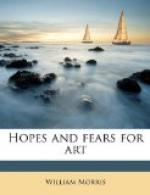The past art of what has grown to be civilised Europe from the time of the decline of the ancient classical peoples, was the outcome of instinct working on an unbroken chain of tradition: it was fed not by knowledge but by hope, and though many a strange and wild illusion mingled with that hope, yet was it human and fruitful ever: many a man it solaced, many a slave in body it freed in soul; boundless pleasure it gave to those who wrought it and those who used it: long and long it lived, passing that torch of hope from hand to hand, while it kept but little record of its best and noblest; for least of all things could it abide to make for itself kings and tyrants: every man’s hand and soul it used, the lowest as the highest, and in its bosom at least were all men free: it did its work, not creating an art more perfect than itself, but rather other things than art, freedom of thought and speech, and the longing for light and knowledge and the coming days that should slay it: and so at last it died in the hour of its highest hope, almost before the greatest men that came of it had passed away from the world. It is dead now; no longing will bring it back to us; no echo of it is left among the peoples whom it once made happy.
Of the art that is to come who may prophesy? But this at least seems to follow from comparing that past with the confusion in which we are now struggling and the light which glimmers through it; that that art will no longer be an art of instinct, of ignorance which is hopeful to learn and strives to see; since ignorance is now no longer hopeful. In this and in many other ways it may differ from the past art, but in one thing it must needs be like it; it will not be an esoteric mystery shared by a little band of superior beings; it will be no more hierarchical than the art of past time was, but like it will be a gift of the people to the people, a thing which everybody can understand, and every one surround with love; it will be a part of every life, and a hindrance to none.
For this is the essence of art, and the thing that is eternal to it, whatever else may be passing and accidental.
Here it is, you see, wherein the art of to-day is so far astray, would that I could say wherein it has been astray; it has been sick because of this packing and peeling with tyranny, and now with what of life it has it must struggle back towards equality.
There is the hard business for us! to get all simple people to care about art, to get them to insist on making it part of their lives, whatever becomes of systems of commerce and labour held perfect by some of us.
This is henceforward for a long time to come the real business of art: and—yes I will say it since I think it—of civilisation too for that matter: but how shall we set to work about it? How shall we give people without traditions of art eyes with which to see the works we do to move them? How shall we give them leisure from toil, and truce with anxiety, so that they may have time to brood over the longing for beauty which men are born with, as ’tis said, even in London streets? And chiefly, for this will breed the others swiftly and certainly, how shall we give them hope and pleasure in their daily work?




